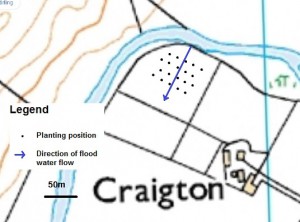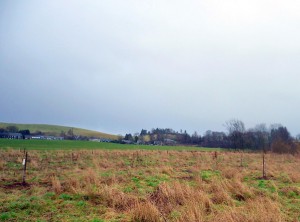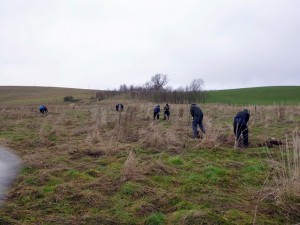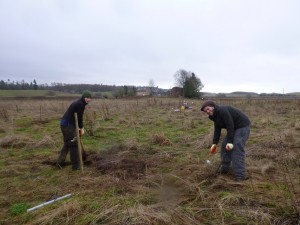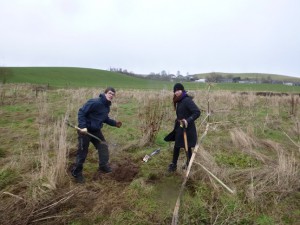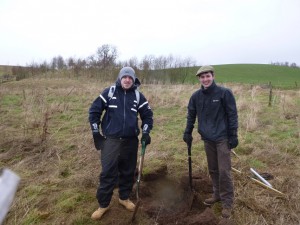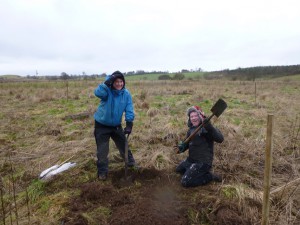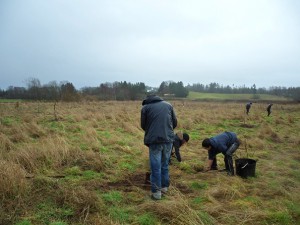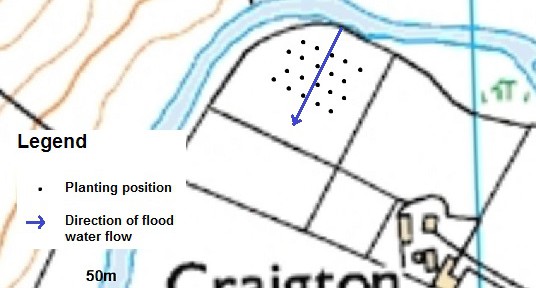
A flood friendly orchard!?! Flooding and orchards is not something you hear commonly associated with one another. Particularly if the orchard is being used to contribute towards minimising flood risk to urban areas. However, the vision of a Natural Flood Management (NFM) orchard that will produce fruit, and absorb groundwater and slow the flow of flood water is what I aimed to achieve at one floodplain site on the Allan Water.
The background to this unusual NFM measure, came about (as much does with NFM) by working with the landowner to achieve any NFM measure that is attractive to them. During consultation, the landowner of Craigton Farm had informed me of an old disused horse field that is on the floodplain, and how she has wanted an orchard planted there for many years. The field is on the upstream corner of a large meander, and is in-line with an area of the river bank where flood water first breaches onto the land at the start of a flood. Following on from the consultation, we received the great news at the end of last year that we had been successfully awarded a grant of £425 through the Central Scotland Green Network’s Orchard Grant Scheme to plant this site.
The £425 grant allowed us to buy 20 orchard trees with protection, including cooking apple, eating apple, plum, pear, sloe and damson varieties. The orchard will become a community orchard that will provide local people with the opportunity to learn how to maintain and harvest an orchard sustainably, whilst also providing free locally grown fruit. The landowner has a background in food security and sustainability, and has already attended a short orchard course, and therefore will make a great figurehead and head prunesman in the Craigton Community Orchard Group.
However, there are two additional considerations we must address before we can plant this orchard. The first is that we want to make the planting benefit flood management, and the second, is that planting on the floodplain may kill trees due to time spent submerged under water. Therefore we had to do two very important things when planting these trees to make sure the NFM orchard was planted correctly. The first action was to adopt a planting design that would slow flood water when passing through the orchard. This was achieved by creating a planting design with no distinct rows or channels facing the direction that the flow of water comes from. The main reason for this, is that distinct rows facing the flow of water would create fast flowing channels of water within the rows that would not be slowing flood water, and may cause erosion issues on the site. However, the planting design does have rows in the opposite direction from the flow of water, so that vegetation in the orchard can still be cut and therefore competition to fruit trees for water and nutrients is kept to a minimum.
The second important action was to use a style of planting called mounding, which involves creating a mound made up of an upturned turf chopped up, and soil. It is in this mound that you plant your tree, and this allows the tree and its root ball to exist above ground level. The reason for using this planting style is that the tree’s roots will spend less time submerged in water, which will greatly reduce the risk of root rot that can kill trees.
With all those finer details resolved, it was now time to plant! On the Saturday just past, 9 hardy NFM volunteers took on the wind and rain at Craigton Farm to make the orchard a reality. The NFM volunteers were all fantastic, and after giving them a background briefing similar to the above, they went out and planted all the trees in their mounds in just over an hour!
Here are some pictures of the volunteers in action!
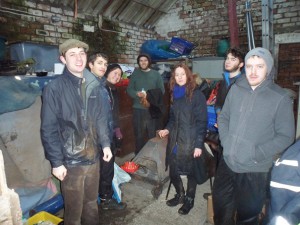
- The NFM Vols. sheltering inside a farm shed for a celebratory post-planting tea and biscuit session!
I would like to take this moment to say a huge thank you to all the volunteers that took part in the NFM orchard tree planting, their good spirits and enthusiasm despite the not so favourable weather conditions made for a really productive and enjoyable day! A Particular big thank you to Natural Communities Apprentice Anna Mayo who volunteered and sourced a couple of new volunteers for the event too!
I personally cannot wait to see this site in the summer when the trees will be a bit more established and hopefully green with foliage, possibly even some of them with fruit! Maybe I’m being a bit too optimistic!
However, this is just the beginning for this young orchard and the Craigton Community Orchard Group. It is a very exciting project and when I think of all the potential benefits these 20 trees can provide, I cannot wait to see how it will all progress!

